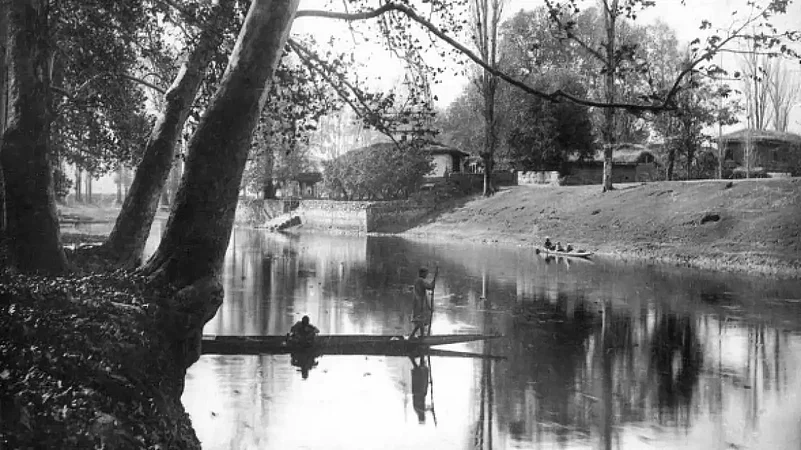The important manuscript Jammu and Kashmir Dilemma of Accession: A Historical Analysis and Lesson would remain one of the most intriguing additions to the historical documentation of the Kashmir dispute if what the author Radha Rajan claims is true.
Published by New Delhi-based Voice of India, Rajan’s book claims that there is a 22-page-long private note that Rai Bahadur Pandit Ramchandra Kak, Prime Minister of J&K during June 1945-August 1947, wrote in 1956 while in exile in Himachal Pradesh’s Kasauli. The note, says the author, was written in third person.
Notably, J&K used to have a Prime Minister until 1965 instead of Chief Minister. Accordingly, the Governor was until 1965 was called Sadr-e-Riyasat which was equivalent of the President.
If authentic, this 22-page-long private note busts many a myths about Kak because the well-known right-wing author Rajan writes that in August 2016, she received a photocopy of this ‘private note’ by a person who chose to be anonymous.
The foreword of Jammu and Kashmir Dilemma of Accession is written by Kak’s grandson Krishen Kak. He writes that no copy of this document, which Rajan claims to be of ‘national importance’, is available in India and the only known copy available is in the India Office Library in London.
The most well-known myths about Kak is that he was pro-Pakistan and wanted Kashmir’s merger with Pakistan in 1947. However, Rajan in the book, quoting Kak’s personal letter, writes that he was not pro-Pakistan but he wanted to safeguard the rights, privileges, and properties for the minority Hindus in Kashmir before committing the princely state to India.
Rajan writes that Kak wanted India and Pakistan to settle down first and when the atmosphere would have been conducive, he would have opted for India and not Pakistan.
In the afterword of the book, Kak’s daughter Lila Bhan writes what her father told her of the accusation of being pro-Pakistan: “Let them say what they say. Finally, I have to face my maker.”
Bhan in her afterword writes that his father made it amply clear to her that he never —even remotely— considered Pakistan as an option for his countrymen of Kashmir.
“My father was very cognizant of the fact that he was a Kashmiri Pandit and there was no future for Kashmiri Pandits in a Muslim Pakistan,” writes Bhan in Rajan’s book’s afterword.
Kak’s 22 page-long letter also has an epilogue where he has made observations about how to settle the Kashmir question. The most intriguing observation that he makes is about the ‘India is fighting two nation-theory’ in Kashmir.
He writes, “The failure of the Congress and, therefore, of the Government of India to find a solution for the Kashmir problem is due to its refusal to face the facts of the situation. Having conceded Pakistan, it is scarcely convincing to say that we are fighting the two-nation theory in Kashmir.
“The two-nation theory is from first to last absurd. Nevertheless Pakistan came into being with the consent of the Indian National Congress on the basis of this theory. Therefore whatever inconsistencies and absurdities underline the theory for practical purposes, it is there and has to be reckoned with. The existence of a large Muslim population in India does not essentially alter the fact.”
Rajan’s Jammu and Kashmir Dilemma of Accession is laced with foul language against Muslims. The author has called Jammu and Kashmir National Conference (NC), All India Muslim League, Muhammad Ali Jinnah, and Sheikh Muhammad Abdullah as jihadis and terrorist organisations.
Rajan is also bitter about Mahatma Gandhi and Pandit Jawaharlal Nehru and accuses them of making Kashmir, which the author claims was always an abode of Hindus, a land unsecure for Kashmiri Pandits. The author also writes that to settle the Kashmir dispute once and for all, the demography of Kashmir, particularly of the Kashmir valley, needs to be changed.
Rajan is also critical of right-wing leader Sardar Patel. She asks why he did not intervene when Gandhi and Nehru were “on a destructive” path when things were happening in Kashmir in August 1947.
Writing about Article 370, Rajan accuses Congress of leaving no way for the abrogation of the Articles 370 and 35-A of the Constitution of India. She writes that if even every trick is tried constitutionally and lawfully, there is no way that Articles 370 and 35-A can be abrogated.
“By applying every trick we reach back to square one. Trying to get rid of Article 370 taking the constitutional way is futile and unproductive. We have created and fattened the grossest aberration whereby the minuscule part is larger than the whole,” notes Rajan.
Yet Prime Minister Narendra Modi’s Bharatiya Janata Party (BJP) government did the unimaginable on August 5, 2019 when it scrapped J&K’s special status and converted the erstwhile state into two Union Territories of J&K and Ladakh.
(Jammu and Kashmir Dilemma of Accession: A Historical Analysis and Lesson is written by Radha Rajan and was published by Voice of India in 2018.)
















